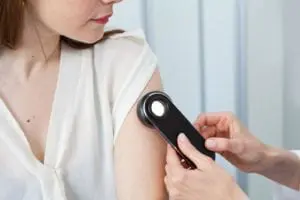Moles are more common than you think they are. There is a good chance that every person has at least a mole or two on their body. People with fairer skin tend to get them more often. However, they do not look exactly alike and may differ in size, colour, shape, location and texture.
For many people, moles are harmless and only a cosmetic concern, but it may indicate something serious for some. To keep tabs on your health, it’s important to get your moles checked by a dermatologist.
If you’re wondering when to worry about moles, it is when there is a change in the way it looks over time. Here is everything you should know about moles and when to see a dermatologist.
What Exactly Are Moles?
Also called nevi, moles are bundles of skin cells that produce pigmentation in your skin. For this reason, most of them are dark and brown in appearance. It is believed that genetics play a role in their creation; however, professionals still aren’t sure of the exact reason behind them. If you have a family history of moles, you are more likely to develop them.
Are They Concerning?

Dermatologist examining birthmarks and moles on a female patient
Most moles are not concerning and develop during childhood or adolescence. They are also likely to disappear on their own over time. However, there is more on when to worry about moles.
Even though most of them are harmless, some tend to become cancerous under certain circumstances. Examining your moles can be an effective way to detect signs of cancerous growth in your skin.
During such evaluations, dermatologists usually look for the following visual cues, called the “ABCs” of moles.
The ABCs of Moles
To determine whether a mole is indicative of skin cancer, dermatologists use the ABCDE method. For all the given categories, they check for abnormalities and changes.
A for Asymmetrical Shape
If a mole is benign, it’s mostly symmetrical. However, if you notice irregularly shaped moles, they may be a sign of melanoma.
B for Border Irregularity
Non-cancerous moles are smooth with even borders. If they are melanoma lesions, their borders may be rough and hard to define. The edges may also be raised or notched.
C for Color
While most of them appear in a single shade of brown, if you notice different blue, black or brown shades, it is exactly when to worry about moles. Melanoma lesions also often appear white, red or colourless.
D for Diameter
Cancerous moles have a bigger diameter compared to non-cancerous ones. To determine whether it is a melanoma lesion or not, check if it is close to the size of a pencil’s eraser.
E for Evolution
If you notice any changes in size, colour or shape, you must see a dermatologist at your earliest. One of the main factors in figuring out any type of skin cancer is being wary of these changes. Melanoma lesions can also cause itching, bleeding and crusting.
Even if moles do not have these qualities, they are not necessarily harmful. Regardless, they should still be examined for presenting a higher risk. A mole biopsy is usually performed by your dermatologist to examine it using more resources. It may need to be removed entirely if there is a positive diagnosis for skin cancer. Based on your diagnosis, your dermatologist will recommend further tests.
However, early detection helps in the treatment of any type of skin cancer. In case it is melanoma, which happens to be the deadliest type of skin cancer, there is a 90% survival rate if it is diagnosed in the early stages.
Cancerous lesions should not be hard to detect as they are mostly the “odd ones out” among all your moles. All in all, they should be oddly shaped, differently coloured and also bigger to qualify for being anything other than a benign mole.
When Should You See a Dermatologist?
Moles and When to See a Dermatologist. There are certain factors that determine when and how often you should see a dermatologist for your moles. Some of them include family history, the number of moles you have, the size. Some people may also have atypical mole syndrome, which means that the person can have at least 50 moles with 3 or 4 that are abnormal in some way.
People at a greater risk of skin cancer must see their dermatologist at least thrice a year. Some can even visit every few months; however, lower-risk individuals may take a yearlong break between evaluations.
Self-evaluation
Regardless of how many times you see your doctor, it’s better to keep an eye on signs and symptoms yourself. Set up an appointment as soon as you notice any differences described above in your moles.
To summarize, watch out for the following:
Moles that bother you by itching or bleeding need immediate evaluation by your dermatologist.
Moles that represent the ABCs of skin cancer need to be looked out for. If they run in your family, you may be at an increased risk of developing them.
New moles: Even though not all new moles are dangerous, you should keep an eye on the ones developing after the age of 20. If they develop in parts of your body with the most exposure to the sun, such as your face, arms, back of your hands etc., then it can be worrying.
Most moles may become skin tags over time are not a sign of skin cancer.
The Good News
On the brighter side, most of your moles are harmless, but it’s better to be safe than sorry. As there are many signs on when to worry about moles, people have a better chance of getting a problem detected and treated early. Therefore, always stay ahead of any serious health concerns by receiving adequate evaluations and keep your skin as healthy as ever. Schedule your exam today.

Recent Comments